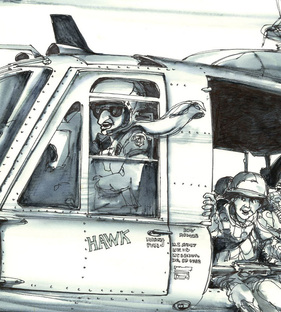 By Julie Titone Through the plexiglass door window, I could see the pilot throw back his head and laugh hysterically, delighted with his own aerial acrobatics. Until he took his helmet off—revealing a bald head and his most distinctive features, a long, hawked nose and a white scarf, worn tied around his neck. “Holy shit, man! Man, we knew you’d be back!” Guys were walking hunched over under the rotating blades to the pilot door, which Hawk had opened, and were giving him the soul fist and patting him on his head. After a brief bit of banter, Hawk squawked, “C’mon, let’s go!” Grady Myers, aka Hoss, knew many soldiers in Vietnam only by their nicknames. I've often wondered about their real names, most especially that of Hawk, who is featured in Grady's art on the cover of "Boocoo Dinky Dow: My short, crazy Vietnam War." Maybe someone who reads this will know the U.S. Army pilot's identity and drop me a note. The scene from the memoir that is quoted above takes place in January 1969 as members of Charlie Company are about to be choppered away from Fire Support Base 30. The colorful pilot pops up again on March 9, 1969, when Grady is wounded during an ambush in the Plei Trap Valley of the Central Highlands. As I waited and listened to the screams of a wounded Vietnamese, a helicopter appeared in the patch of sky that broke through the tall trees above my head. The small, hornet-like Loach chopper, with its mini-guns, was moving in a tight circle. I was relieved, especially when I saw Hawk’s long scarf dangle as the pilot stuck his head out the window. The cavalry had arrived. I'd like to give a shout-out to the many brave soldiers who flew in 'Nam, including folks in the Vietnam Helicopter Crew Members Association. They served in the first conflict that saw wide-scale tactical deployment of helicopters, which served as troop ships, warships and ambulances. Had it not been for the helicopter that whisked him off the battlefield, Grady might not have survived to tell his stories.
2 Comments
5/8/2013 08:16:37 pm
I was a medic and always close to our 3rd platoon radio, and can remember their voices shaking in the radio with the shaking of the slick. These guys were the keystone that kept everything going. Whether slick, cobra or medivac I'll always have fond memories and total respect for these guys.
Reply
Julie
5/8/2013 11:49:55 pm
Thanks for sharing the memory, Donald.
Reply
Leave a Reply. |
Julie Titone is co-author of the Grady Myers memoir "Boocoo Dinky Dow: My short, crazy Vietnam War." Grady was an M-60 machine gunner in The U.S. Army's Company C’s 2nd Platoon, 1st Battalion, 8th Regiment, 4th Infantry Division in late 1968 and early 1969. His Charlie Company comrades knew him as Hoss. Thoughts, comments? Send Julie an email. Archives
November 2018
|
 RSS Feed
RSS Feed